simon morley
sept. 11 - oct. 23, 2004 |
|
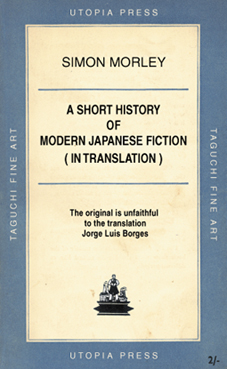
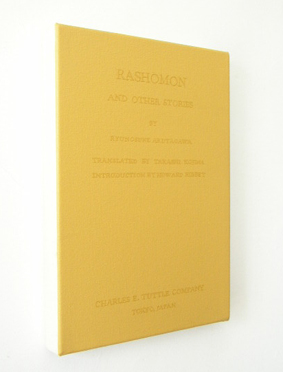
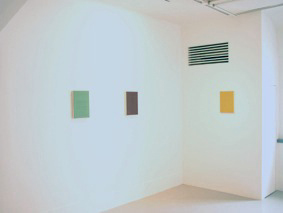
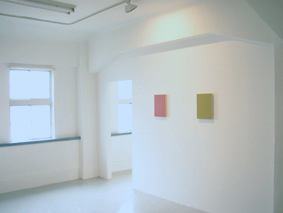
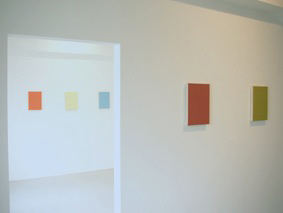
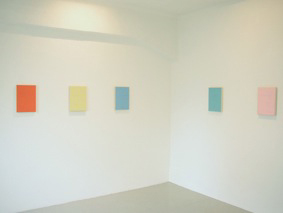
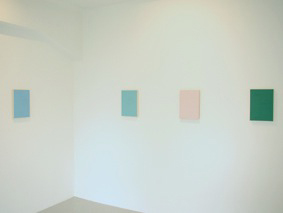
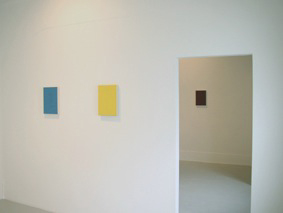
|
Simon Morley was born in Eastbourne, England in 1958. Got BA of modern history at Mansfield college, Oxford University in 1980 and MA of fine art at Goldsmith's college, University of London in 1998. Based in London, participates artist-in-residence in various places as the Wordsworth Trust in Grasmere and the British School in Rome. Besides creating art works, he also curates exhibitions as "Chora (1999)" and "The Wreck of Hope (2000)". Recently he published a study on art history, "Writing on the Wall - Word and Image in Modern Art, Thames and Hudson, 2003". Word and ImageHis work always deals the relation between word and image as: "word painting (VIRUS series)" - words from certain text are painted with randomly floating multicoloured letters, "signature painting" - a signature by prominent figure is enlarged and painted on the wall of certain place to which the person has relation, "label painting" - hand painted labels to explain works displayed at an exhibition, "book painting" - cover or title page of a book is transcribed on canvas, "postcard painting" - postcards collected from bric-a-brac shops are reproduced on canvas, a work in which photographs of gravestones and words from poems are combined into pairs, a video work showing 10 different mouths saying the last lines of Wordsworth's poem in slow motion without sound, and books published by imaginary publisher, Utopia Press.This time works of "book painting" will be displayed at taguchi fine art, ltd. Book paintingThe book paintings relates the dynamics of seeing and reading, immediate sensual experience and memory. The subject of the books is chosen for cultural resonance and in relation to the specifics of the locations in which the paintings are exhibited. Colours are chosen intuitively, sometimes in relation to the books themselves, sometimes in relation to the place in which the works are painted, sometimes in relation to the group of paintings themselves. The text is always painted exactly same as the original books, only a tone darker than the ground in order to confuse the figure-ground relationships and to slow down perceputual-reading response.At his one person show at Percy Miller Gallery, London in 2000, book paintings based on first editions of the books by George Orwell as "1984", "Animal Farm" and "Hommage to Catalonia" are exhibited. The reason why Morley, an English artist chose George Orwell for his first book painting show in London is that Orwell is conceived to symbolise a certain very British ideal art and its role in society. White was chosen for the color of these paintings and texts are painted in light gray because it seemed appropriate. He also wanted viewers to consider about monochrome abstraction with them. At his next show at Galerie Zero, Piacenza, Italy in 2001, titled "Italian Holiday", exhibited are book paintings based on guidebooks of Italian cities as "Rome", "Venice", "Siena" and "Pompei", and an old photo album of a woman containing postcards sent from Italy, found in second hand shop in his hometown. He painted guidebooks of the cities where the owner of the photo album visited in her travel. For these paintings, Morley chose various pastel colors which reminds us Italian sorbet, jelato for their background. A Short History of Modern Japanese FictionFor his first show in Japan, Morley decided to produce book paintings based on English translation of modern and contemporary Japanese fictions. This time he chose 13 fictions: "The Wild Geese" by Mori Ogai, "Kokoro" by Natsume Soseki, "Rashomon" by Akutagawa Ryunosuke, "Quicksand" by Tanizaki Junichiro, "Shanghai" by Yokomitsu Riichi, "The Snow Country" by Kawabata Yasunari, "Thirst for Love" by Mishima Yukio, "The Woman in the Dunes" by Abe Kobo, "The Silent Cry" by Oe Kenzaburo, "Almost Transparent Blue" by Murakami Ryu, "The Samurai" by Endo Shusaku, "Kitchen" by Yoshimoto Banana and "The Wind-up Bird Chronicle" by Murakami Haruki. He read all these books. The colors are typical Japanese color he thought, from a catalogue of wood block prints by Katsushika Hokusai.TranslationBeside Yoshimoto Banana or Murakami Haruki, these days many Japanese fictions are translated into foreign languages immediately after those publications. Morley who has a profound knowledge of literature usually enjoys these translations.However, always there exists a question, is translation of literature possible at all ? Needless to say, if we only change a word of one language into the equal word of another language, the translation would be imperfect. Every word has its historical meaning peculiar to the race. Translator is required to be familiar with the background of the original work culturally, historically, and socially. And to convey it to readers without loosing the atmosphere coming from the style of the sentences or the writer's thought between the lines. We are, in greater or lesser degrees, always aware of this difficulty of translation of literature. How about in the case of visual art ? It is believed that we do not need to translate works of visual art and that it could be understood beyond the barrier of language. However, we can easily find it is obviously an illusion when just considering about the necessity of the study iconology for Christian art. Then how about modern art which based on pure visual language ? How about contemporary art ? How about music, architecture, science or politics ... ? Currently globalization is propelled and there is a tendency that information seems to be owned in common. We are therefore easily to believe that we have common culture and common recognition. This is not only a case between people in the different cultures, but also between the individuals living in the same cultures. The range and the depth of recognition by one person would be different from those by others. Then how mutual understanding with another person would be possible ? Simon Morley, presenting the questions of the translation in literature with his colourful book paintings, does hope viewers to consider about various issues as the difference of culture, difference of personalities, or mutual understanding. This installation at taguchi fine art, ltd. is the first occasion of the installation of the works by Simon Morley in Japan. On the first day, September 11, we had a speech by the artist. checklist of the installation 1. Mori Ogai, "The Wild Geese," 2004 acrylic on canvas 36 x 26 cm 2. Natsume Soseki, "Kokoro," 2004 acrylic on canvas 36 x 26 cm 3. Akutagawa Ryunosuke, "Rashomon," 2004 acrylic on canvas 36 x 26 cm 4. Tanizaki Junichiro, "Quick Sand," 2004 acrylic on canvas 36 x 26 cm 5. Yokomitsu Riichi, "Shanghai," 2004 acrylic on canvas 36 x 26 cm 6. Kawabata Yasunari, "The Snow Country," 2004 acrylic on canvas 36 x 26 cm 7. Mishima Yukio, "The Thirst for Love," 2004 acrylic on canvas 36 x 26 cm 8. Abe Kobo, "The Woman in the Dunes," 2004 acrylic on canvas 36 x 26 cm 9. Oe Kenzaburo, "The Silent Cry," 2004 acrylic on canvas 36 x 26 cm 10. Murakami Ryu, "Almost Transparent Blue," 2004 acrylic on canvas 36 x 26 cm 11. Endo Shusaku, "The Samurai," 2004 acrylic on canvas 36 x 26 cm 12. Yoshimoto Banana, "Kitchen," 2004 acrylic on canvas 36 x 26 cm 13. Murakami Haruki, "The Wind-up Bird Chronicle," 2004 acrylic on canvas 36 x 26 cm |